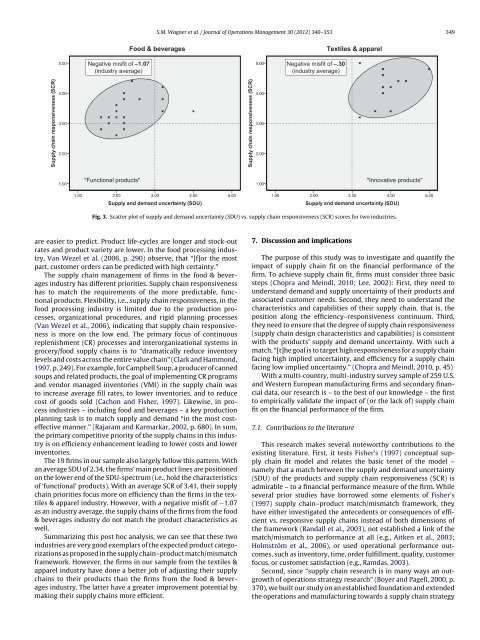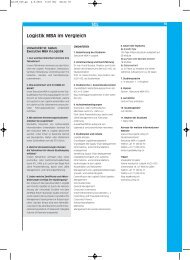The link between supply chain fit and financial - MBA, Supply Chain ...
The link between supply chain fit and financial - MBA, Supply Chain ...
The link between supply chain fit and financial - MBA, Supply Chain ...
Create successful ePaper yourself
Turn your PDF publications into a flip-book with our unique Google optimized e-Paper software.
Negative mis<strong>fit</strong> of –1.07<br />
(industry average)<br />
S.M. Wagner et al. / Journal of Operations Management 30 (2012) 340–353 349<br />
Food & beverages Textiles & apparel<br />
Negative mis<strong>fit</strong><br />
of –.30<br />
(industry average)<br />
"Functional products"<br />
"Innovative products"<br />
Fig. 3. Scatter plot of <strong>supply</strong> <strong>and</strong> dem<strong>and</strong> uncertainty (SDU) vs. <strong>supply</strong> <strong>chain</strong> responsiveness (SCR) scores for two industries.<br />
are easier to predict. Product life-cycles are longer <strong>and</strong> stock-out<br />
rates <strong>and</strong> product variety are lower. In the food processing industry,<br />
Van Wezel et al. (2006, p. 290) observe, that “[f]or the most<br />
part, customer orders can be predicted with high certainty.”<br />
<strong>The</strong> <strong>supply</strong> <strong>chain</strong> management of firms in the food & beverages<br />
industry has different priorities. <strong>Supply</strong> <strong>chain</strong> responsiveness<br />
has to match the requirements of the more predictable, functional<br />
products. Flexibility, i.e., <strong>supply</strong> <strong>chain</strong> responsiveness, in the<br />
food processing industry is limited due to the production processes,<br />
organizational procedures, <strong>and</strong> rigid planning processes<br />
(Van Wezel et al., 2006), indicating that <strong>supply</strong> <strong>chain</strong> responsiveness<br />
is more on the low end. <strong>The</strong> primary focus of continuous<br />
replenishment (CR) processes <strong>and</strong> interorganizational systems in<br />
grocery/food <strong>supply</strong> <strong>chain</strong>s is to “dramatically reduce inventory<br />
levels <strong>and</strong> costs across the entire value <strong>chain</strong>” (Clark <strong>and</strong> Hammond,<br />
1997, p. 249). For example, for Campbell Soup, a producer of canned<br />
soups <strong>and</strong> related products, the goal of implementing CR programs<br />
<strong>and</strong> vendor managed inventories (VMI) in the <strong>supply</strong> <strong>chain</strong> was<br />
to increase average fill rates, to lower inventories, <strong>and</strong> to reduce<br />
cost of goods sold (Cachon <strong>and</strong> Fisher, 1997). Likewise, in process<br />
industries – including food <strong>and</strong> beverages – a key production<br />
planning task is to match <strong>supply</strong> <strong>and</strong> dem<strong>and</strong> “in the most costeffective<br />
manner.” (Rajaram <strong>and</strong> Karmarkar, 2002, p. 680). In sum,<br />
the primary competitive priority of the <strong>supply</strong> <strong>chain</strong>s in this industry<br />
is on efficiency enhancement leading to lower costs <strong>and</strong> lower<br />
inventories.<br />
<strong>The</strong> 19 firms in our sample also largely follow this pattern. With<br />
an average SDU of 2.34, the firms’ main product lines are positioned<br />
on the lower end of the SDU-spectrum (i.e., hold the characteristics<br />
of ‘functional’ products). With an average SCR of 3.41, their <strong>supply</strong><br />
<strong>chain</strong> priorities focus more on efficiency than the firms in the textiles<br />
& apparel industry. However, with a negative mis<strong>fit</strong> of −1.07<br />
as an industry average, the <strong>supply</strong> <strong>chain</strong>s of the firms from the food<br />
& beverages industry do not match the product characteristics as<br />
well.<br />
Summarizing this post hoc analysis, we can see that these two<br />
industries are very good exemplars of the expected product categorizations<br />
as proposed in the <strong>supply</strong> <strong>chain</strong>–product match/mismatch<br />
framework. However, the firms in our sample from the textiles &<br />
apparel industry have done a better job of adjusting their <strong>supply</strong><br />
<strong>chain</strong>s to their products than the firms from the food & beverages<br />
industry. <strong>The</strong> latter have a greater improvement potential by<br />
making their <strong>supply</strong> <strong>chain</strong>s more efficient.<br />
7. Discussion <strong>and</strong> implications<br />
<strong>The</strong> purpose of this study was to investigate <strong>and</strong> quantify the<br />
impact of <strong>supply</strong> <strong>chain</strong> <strong>fit</strong> on the <strong>financial</strong> performance of the<br />
firm. To achieve <strong>supply</strong> <strong>chain</strong> <strong>fit</strong>, firms must consider three basic<br />
steps (Chopra <strong>and</strong> Meindl, 2010; Lee, 2002): First, they need to<br />
underst<strong>and</strong> dem<strong>and</strong> <strong>and</strong> <strong>supply</strong> uncertainty of their products <strong>and</strong><br />
associated customer needs. Second, they need to underst<strong>and</strong> the<br />
characteristics <strong>and</strong> capabilities of their <strong>supply</strong> <strong>chain</strong>, that is, the<br />
position along the efficiency–responsiveness continuum. Third,<br />
they need to ensure that the degree of <strong>supply</strong> <strong>chain</strong> responsiveness<br />
(<strong>supply</strong> <strong>chain</strong> design characteristics <strong>and</strong> capabilities) is consistent<br />
with the products’ <strong>supply</strong> <strong>and</strong> dem<strong>and</strong> uncertainty. With such a<br />
match, “[t]he goal is to target high responsiveness for a <strong>supply</strong> <strong>chain</strong><br />
facing high implied uncertainty, <strong>and</strong> efficiency for a <strong>supply</strong> <strong>chain</strong><br />
facing low implied uncertainty.” (Chopra <strong>and</strong> Meindl, 2010, p. 45)<br />
With a multi-country, multi-industry survey sample of 259 U.S.<br />
<strong>and</strong> Western European manufacturing firms <strong>and</strong> secondary <strong>financial</strong><br />
data, our research is – to the best of our knowledge – the first<br />
to empirically validate the impact of (or the lack of) <strong>supply</strong> <strong>chain</strong><br />
<strong>fit</strong> on the <strong>financial</strong> performance of the firm.<br />
7.1. Contributions to the literature<br />
This research makes several noteworthy contributions to the<br />
existing literature. First, it tests Fisher’s (1997) conceptual <strong>supply</strong><br />
<strong>chain</strong> <strong>fit</strong> model <strong>and</strong> relates the basic tenet of the model –<br />
namely that a match <strong>between</strong> the <strong>supply</strong> <strong>and</strong> dem<strong>and</strong> uncertainty<br />
(SDU) of the products <strong>and</strong> <strong>supply</strong> <strong>chain</strong> responsiveness (SCR) is<br />
admirable – to a <strong>financial</strong> performance measure of the firm. While<br />
several prior studies have borrowed some elements of Fisher’s<br />
(1997) <strong>supply</strong> <strong>chain</strong>–product match/mismatch framework, they<br />
have either investigated the antecedents or consequences of efficient<br />
vs. responsive <strong>supply</strong> <strong>chain</strong>s instead of both dimensions of<br />
the framework (R<strong>and</strong>all et al., 2003), not established a <strong>link</strong> of the<br />
match/mismatch to performance at all (e.g., Aitken et al., 2003;<br />
Holmström et al., 2006), or used operational performance outcomes,<br />
such as inventory, time, order fulfillment, quality, customer<br />
focus, or customer satisfaction (e.g., Ramdas, 2003).<br />
Second, since “<strong>supply</strong> <strong>chain</strong> research is in many ways an outgrowth<br />
of operations strategy research” (Boyer <strong>and</strong> Pagell, 2000, p.<br />
370), we built our study on an established foundation <strong>and</strong> extended<br />
the operations <strong>and</strong> manufacturing towards a <strong>supply</strong> <strong>chain</strong> strategy






